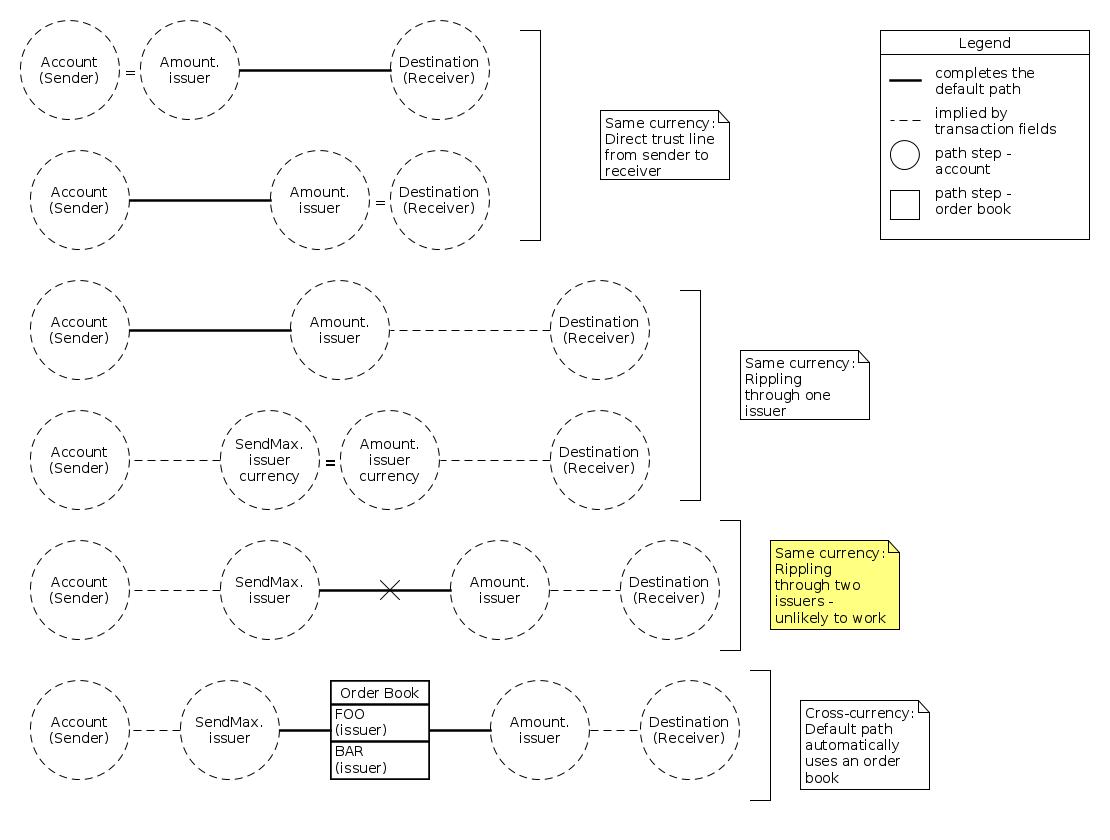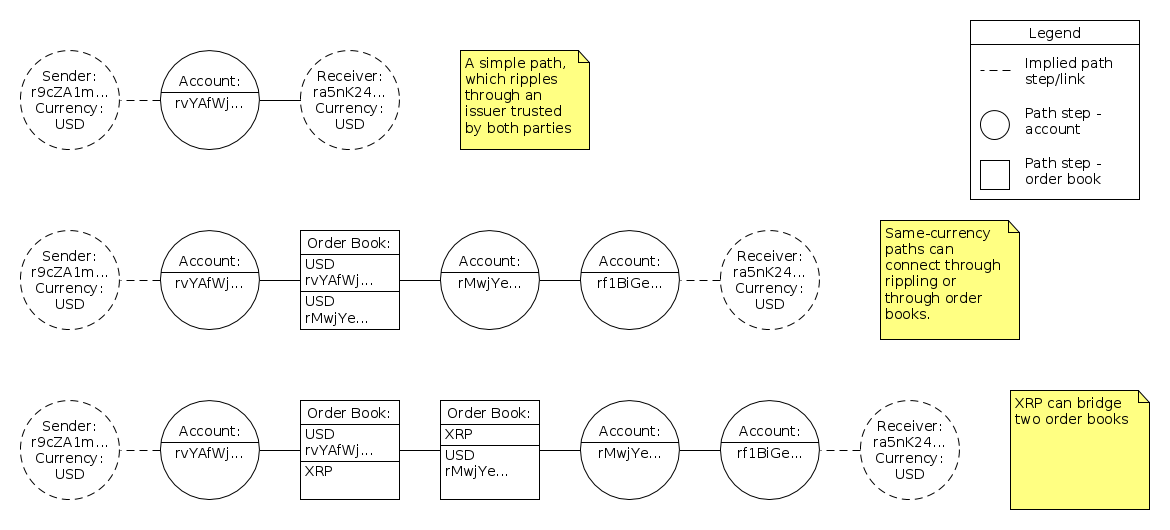Paths
In the Ripple Consensus Ledger, paths define a way for payments to flow through intermediary steps on their way from sender to receiver. Paths enable cross-currency payments by connecting sender and receiver through order books. Paths also enable complex settlement of offsetting debts.
A single Payment transaction in the Ripple Consensus Ledger can use multiple paths, combining liquidity from different sources to deliver the desired amount. Thus, a transaction includes a path set, which is a collection of possible paths to take. The paths in a path set must start and end with the same currency.
Since XRP can be sent directly to any address, an XRP-to-XRP transaction does not use any paths.
Path Steps
A path is made of steps that connect the sender to the receiver of the payment. Every step is either:
- Rippling through another address with the same currency
- Exchanging currency at an order book
Rippling through another address is the process of moving debt around. In the typical case, this involves reducing an issuer's obligation to one party and increasing the obligation to another party. Rippling can occur between any addresses that are connected by trust lines. See Understanding the NoRipple Flag for more examples of rippling.
In the case of a currency exchange step, the path step specifies which currency to change to, but does not record the state of the Offers in the order book. The canonical order of transactions is not final until a ledger is validated, so you cannot know for certain which Offers a transaction will take, until after the transaction has been validated. (You can make an educated guess, since each transaction takes the best available Offers at the time it executes in the final ledger.)
In both types of steps, each intermediate address gains and loses approximately equal value: either a balance ripples from a trust line to another trust line in the same currency, or they exchange currencies according to a previously-placed order. In some cases, the amounts gained and lost may not be exactly equivalent, due to transfer fees, trust line quality, or rounding.
Technical Details
Pathfinding
The rippled API has two methods that can be used for pathfinding. The ripple_path_find command does a one-time lookup of possible path sets. The path_find command (WebSocket only) expands on the search with follow-up responses whenever a ledger closes or the server finds a better path.
You can have rippled automatically fill in paths when you sign it, by including the build_path field in a request to the sign command or submit command (sign-and-submit mode). However, we recommend pathfinding separately and confirming the results before signing, to avoid surprises.
Caution: Although rippled is designed to search for the cheapest paths possible, it may not always find them. Untrustworthy rippled instances could also be modified to change this behavior for profit. The actual cost to execute a payment along a path can change between submission and transaction execution.
Finding paths is a very challenging problem that changes slightly every few seconds as new ledgers are validated, so rippled is not designed to find the absolute best path. Still, you can find several possible paths and estimate the cost of delivering a particular amount.
Implied Steps
By convention, several steps of a path are implied by the fields of the Payment transaction: specifically, the Account (sender), Destination (receiver), Amount (currency and amount to be delivered) and SendMax (currency and amount to be sent, if specified). The implied steps are as follows:
- The first step of a path is always implied to be the sender of the transaction, as defined by the transaction's
Accountfield. - If the transaction includes a
SendMaxfield with anissuerthat is not the sender of the transaction, that issuer is implied to be the second step of the path.- If
issuerof theSendMaxis the sending address, then the path starts at the sending address, and may use any of that address's trust lines in the given currency. See special values for SendMax and Amount for details.
- If
- If the
Amountfield of the transaction includes anissuerthat is not the same as theDestinationof the transaction, that issuer is implied to be the second-to-last step of the path. - Finally, last step of a path is always implied to be the receiver of a transaction, as defined by the transaction's
Destinationfield.
Default Paths
In addition to explicitly specified paths, a transaction can execute along the default path. The default path is the simplest possible way to connect the implied steps of the transaction.
The default path could be any of the following:
- If the transaction is uses only one currency (regardless of issuer), then the default path assumes the payment should ripple through the addresses involved. This path only works if those addresses are connected by trust lines.
- If
SendMaxis omitted, or theissuerof theSendMaxis the sender, the default path needs a trust line from the sendingAccountto theissuerof the destinationAmountto work. - If the
SendMaxandAmounthave differentissuervalues, and neither are the sender or receiver, the default path is probably not useful because it would need to ripple across a trust line between the two issuers. Ripple (the company) typically discourages issuers from trusting one another directly.
- If
- For cross-currency transactions, the default path uses the order book between the source currency (as specified in the
SendMaxfield) and the destination currency (as specified in theAmountfield).
The following diagram enumerates all possible default paths:

You can use the tfNoDirectRipple flag to disable the default path. In this case, the transaction can only execute using the paths explicitly included in the transaction. Traders can use this option to take arbitrage opportunities.
Path Specifications
A path set is an array. Each member of the path set is another array that represents an individual path. Each member of a path is an object that specifies the step. A step has the following fields:
| Field | Value | Description |
|---|---|---|
account |
String - Address | (Optional) If present, this path step represents rippling through the specified address. MUST NOT be provided if this step specifies the currency or issuer fields. |
currency |
String - Currency Code | (Optional) If present, this path step represents changing currencies through an order book. The currency specified indicates the new currency. MUST NOT be provided if this step specifies the account field. |
issuer |
String - Address | (Optional) If present, this path step represents changing currencies and this address defines the issuer of the new currency. If omitted in a step with a non-XRP currency, a previous step of the path defines the issuer. If present when currency is omitted, indicates a path step that uses an order book between same-named currencies with different issuers. MUST be omitted if the currency is XRP. MUST NOT be provided if this step specifies the account field. |
type |
Integer | DEPRECATED (Optional) An indicator of which other fields are present. |
type_hex |
String | DEPRECATED: (Optional) A hexadecimal representation of the type field. |
In summary, the following combination of fields are valid, optionally with type, type_hex, or both:
accountby itselfcurrencyby itselfcurrencyandissueras long as thecurrencyis not XRPissuerby itself
Any other use of account, currency, and issuer fields in a path step is invalid.
The type field, used for the binary serialization of a path set, is actually constructed through bitwise operations on a single integer. The bits are defined as follows:
| Value (Hex) | Value (Decimal) | Description |
|---|---|---|
| 0x01 | 1 | A change of address (rippling): the account field is present. |
| 0x10 | 16 | A change of currency: the currency field is present. |
| 0x20 | 32 | A change of issuer: the issuer field is present. |

